Money trees are popular houseplants due to their unique braided trunks and lush foliage. Money trees can live for several years, however they do require regular care in order to thrive. Money tree owners often encounter issues with their plants dying and not knowing what has caused it.
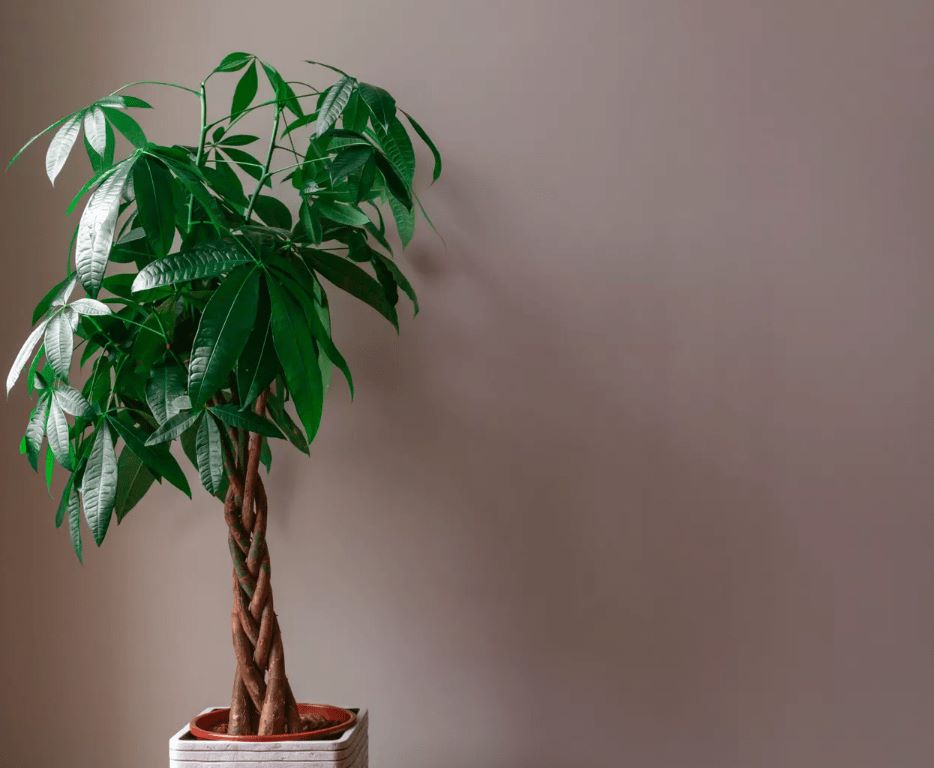
If your money tree’s leaves are turning yellow or brown and dropping off, it likely means that the conditions in which you have been caring for it are not ideal. To revive a money tree dying, it is important to recreate a humid environment, keep the soil consistently moist and to shade the plant from direct sunlight. Money trees can tolerate the typical range of temperatures of most homes, preferring a temperature range of 53.6°F and 77°F (12°C and 25°C).
Why is My Tree Dying?
Money tree plants are a popular choice for decoration and gifting due to their low maintenance requirements and unique design. Unfortunately, money trees can become ill if not cared for properly. Symptoms of an unhealthy money tree include yellowing leaves, brown spots, wilting branches, and sparse leaves.
A Quick Note on Money Trees in Dormancy
When the days become cooler and shorter, the Money Tree may enter a period of dormancy in order to conserve energy. During this time, it will stop growing and its leaves may begin to yellow or fall off. A money tree may remain dormant for up to several months during winter.
When it comes to fertilizer, the application should be reduced during winter months. When fertilizing, try to avoid chemical-based products and opt for an organic fertilizer instead. To ensure your plant remains healthy through dormancy, use a balanced fertilizer with equal parts nitrogen, phosphorus, and potassium once per month from November through March.
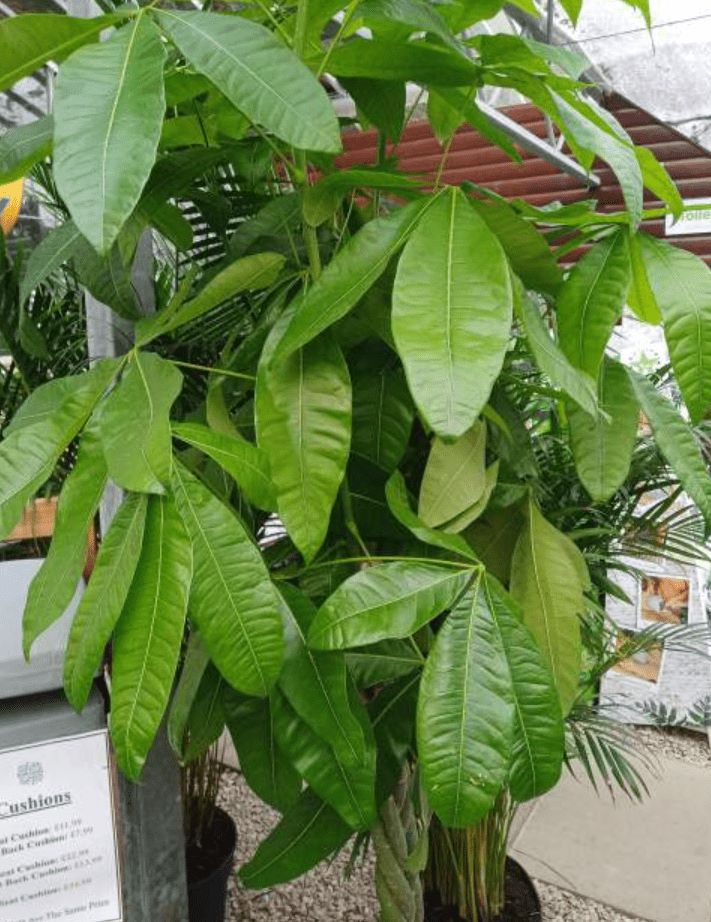
In addition to fertilizing, make sure your Money Tree is receiving adequate moisture. The soil should always be kept moist but not soggy, so check the dirt every week by sticking your finger in it and feeling for dampness. Water when necessary, and make sure the plant’s pot has a drainage hole to avoid waterlogging.
A Quick Note on New Plants
When it comes to Money Trees, a quick note on new plants is important to keep in mind. A Money Tree is accustomed to its environment and can be easily shocked or put into survival mode by any sudden changes. A common example of this occurs when a Money Tree is relocated or transplanted.
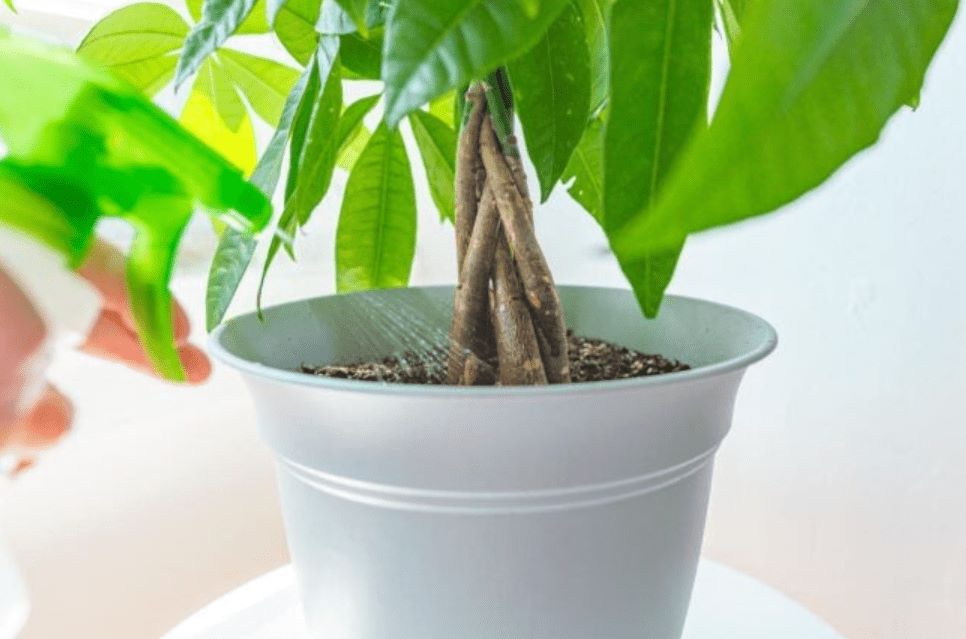
The plant experiences a major change in environment, light and water exposure.
To help your Money Tree recover from shock, you should provide it with indirect sunlight for at least 4 to 6 hours per day. This will ensure the leaves receive enough light while not being overwhelmed by direct sun rays.
When should I fertilize my money plant? It is generally advised to fertilize your plant once a month during the growing season.
A Quick Note on Proper Watering Habits for Money Trees
Money Trees need just the right amount of water to be able to grow and look their best. A good rule of thumb is to check the soil each week, and if it’s dry an inch below the surface, it’s time to water your plant. A good way to measure exactly how much water you’re giving your Money Tree is to smart to establish a good watering routine for your plant.
Overwatering Money Trees
Money trees (Pachira aquatica) are a popular and attractive houseplant, but they can be particularly susceptible to overwatering. Overwatering can cause root rot, which is when the roots of the money tree become submerged in water for too long and cannot process it fast enough. This leads to a lack of oxygen and nutrients.
Symptoms of root rot include the yellowing and wilting of leaves, a foul smell coming from the soil, and mushy roots.
To avoid overwatering your Money Tree, make sure you are using potting soil that has good drainage and only water when the top two inches of soil feels dry.
Also, ensure that there are adequate drainage holes in the planter. It is important to prevent water from pooling at the bottom and not draining away quickly.
If you believe your Money Tree may have root rot, it is important to act fast. Remove the plant from its pot, clean off the affected roots with a sterile knife.
Overwatering can cause root rot, which is when the roots become submerged in water for too long, preventing them from accessing oxygen and nutrients. Symptoms can include yellowing and wilting leaves, a foul smell coming.
Underwatering Money Trees
Underwatering Money Trees can be just as detrimental to their health and beauty as overwatering. Not only do Money Trees need plenty of water and humidity to thrive, but their roots also require a certain amount of moisture in order to remain healthy. Underwatering can lead to wilting leaves, yellowing foliage and dry soil that pulls away from the sides of the pot. If you notice any of these signs, it’s time to water your Money Tree right away! It’s important to avoid letting the soil get too dry in between watering sessions, as this can decrease its lifespan and cause permanent damage to the roots. To make sure that your Money Tree is properly hydrated.
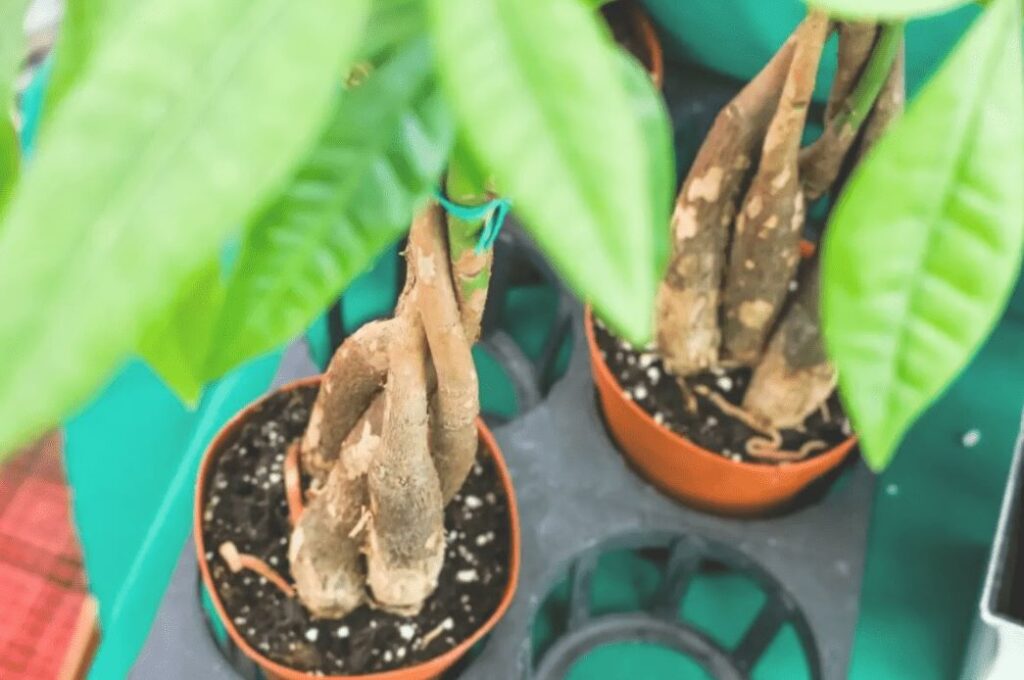
Make sure you water your Money Tree when the top 1-2″ of soil begins to feel dry. Remember that Money Trees need more frequent watering in warmer months, so be sure to check the soil regularly during these times. Additionally, misting your plant with a light spray of water can help provide additional humidity and moisture needed for a healthy Money Tree.
Why Is My Money Tree Displaying These Symptoms?
When caring for your Money Tree, it’s important to be aware of the signs that your plant may not be doing well. There are several key symptoms you should keep an eye out for, such as yellowing or drooping leaves, brown spots on the leaves or stems, and stunted growth.
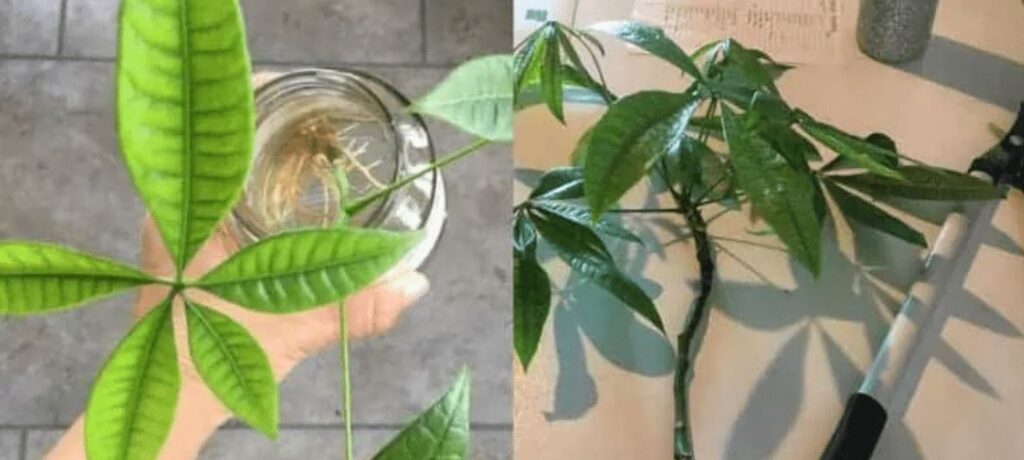
Why Is My Money Tree Drooping?
The Problem:
Money trees (Pachira aquatica) are a popular choice for both indoor and outdoor décor, and with good reason: their glossy, dark green leaves and unique braided trunk give them an attractive look. Unfortunately, however, these lovely leaves can start to droop, leaving you wondering why your money tree is not looking its best.
Why Is It Happening?:
OVERWATERING: When it comes to giving your Money Tree too much water, the results can be disastrous. The excess water can damage the roots, leading to a variety of symptoms including drooping or yellowing leaves. This is because damaged roots are unable to pass on water and nutrients to the other parts of the plant.
UNDERWATERING: Underwatering is a common issue that many Money Tree owners experience. If your Money Tree appears to be drooping, it could be the result of not giving your tree enough water. To determine if underwatering is the cause, the soil should be examined closely – if it feels bone dry and there are curled or wrinkled leaves on the addition to the drooping, your issue is underwatering.
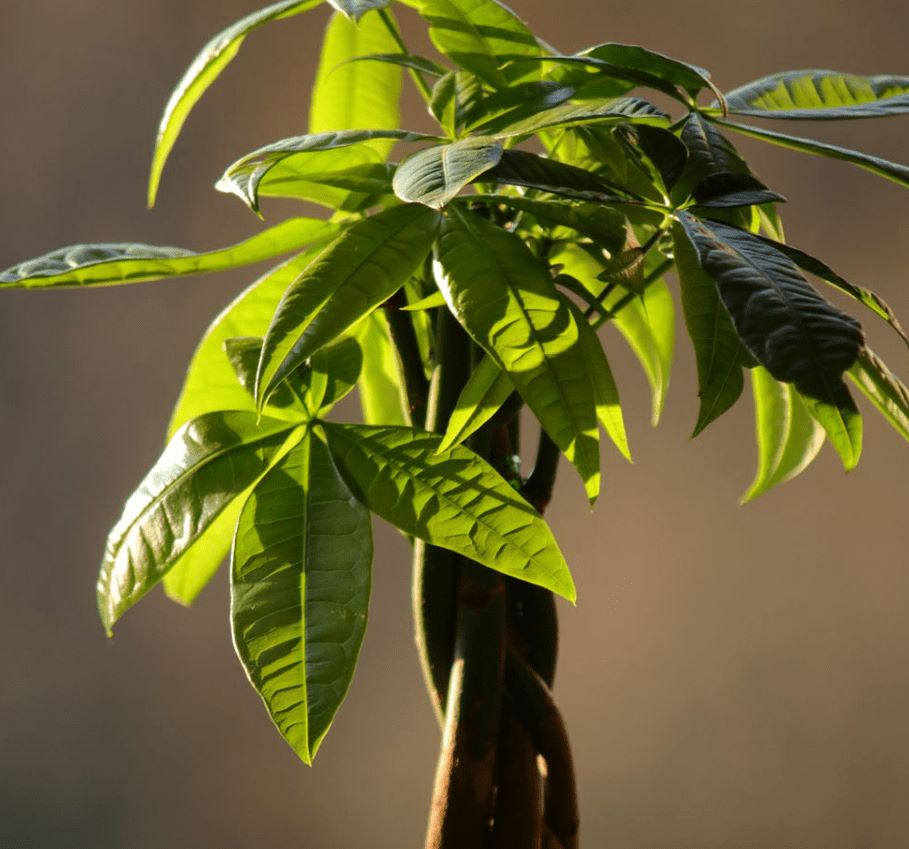
The Solution:
OVERWATERING: Overwatering your Money Tree can cause significant damage to the plant if not addressed in a timely manner. It is important to take steps to ensure that your Money Tree is receiving the right amount of water each day, and that its container has proper drainage capabilities.
If you suspect your Money Tree has been overwatered, the first step is to make sure it is planted in the proper container. Pots without drainage holes, or with small holes that have become plugged, can cause the soil to become overly wet. If this has occurred, you should either unplug your drainage holes or replant the Money Tree into a new container with proper drainage capabilities.
Once you’ve chosen a container with the right drainage, you must be careful not to overwater. Check your soil each day and water only when the top 1-2″ of soil become dry. You should also use a saucer beneath your plant so that any excess water can drain away quickly and easily.
UNDERWATERING: Underwatering your Money Tree can have serious consequences for its health, making it important to remember that your plant must not be neglected. Money Trees typically require water every 7-10 days in order to stay healthy and vibrant, though the exact amount of water required will vary depending on the size of the pot and the environment in which.
If you are unsure, it’s best to err on the side of caution and water your Money Tree more frequently than not.
If your Money Tree is drooping or wilted, this could be a sign that you need to start watering it more regularly. To properly water your Money Tree, use room-temperature water and make sure the soil is evenly saturated. Allow the water to drain from the bottom of the pot and then discard any excess. To make sure that you’re not over-watering, remove any standing water beneath the planter when done and check for signs of overwatering such as root rot, yellowed or droopy leaves, or excessive.
Why Are My Money Tree Leaves Wrinkled and Curling?
If you notice that your plant’s leaves are starting to wrinkle or curl, or if the dirt in your planter appears to be pulling back from the sides of the pot, your plant is probably thirsty.
The Problem:
Wrinkling and curling of Money Tree leaves is usually caused by dehydration. If there has been a lapse in watering, the lack of moisture can cause the leaves to start to wrinkle or curl. Overwatering can also lead to leaf wrinkling as soggy soil will not allow for adequate oxygenation.
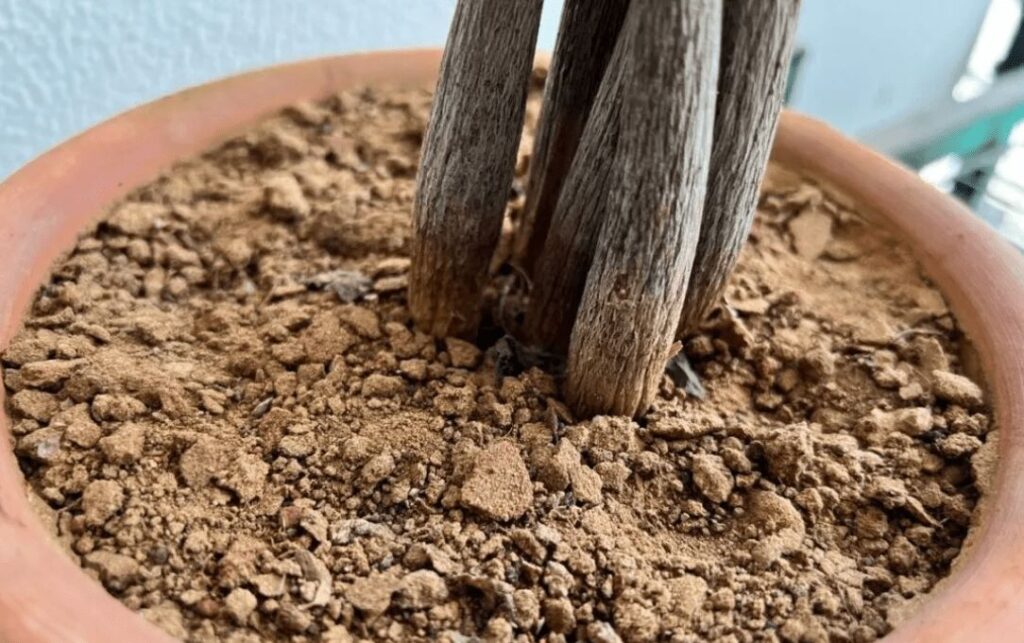
Why Is It Happening?:
UNDERWATERING: Underwatering is a common issue with Money Tree plants, which can manifest itself in the leaves becoming wrinkled, wavy, or curled. This is an early sign of dehydration and often times can be reversed if you start to improve your watering techniques. When this happens it’s important to act quickly because if you don’t the leaf could.
The Solution:
UNDERWATERING: Underwatering is a common issue that affects Money Trees, as well as many other plants. The symptoms are often visible before the problem can be identified. The leaves of the Money Tree become curled and wrinkled, a sign that the soil may be too dry. The solution to this problem is to check the soil and water it thoroughly.
Money Tree Leaves Drooping, Turning Yellow and Dying
- Symptoms. Yellow leaves that droop or wilt can be a sign of numerous stressors or diseases in plants. Wilting and yellowing of leaves could indicate that the plant is not getting enough water, is under attack from pests or pathogens, experiencing nutrient deficiencies, being exposed to extreme temperatures or weather conditions, or suffering from some kind of root damage.
- Causes. One of the main causes of a plant being unhealthy is its pot size being too small. When the roots of the plant have taken up all the available nutrients due to the limited space, it becomes difficult for the plant to maintain its health. Furthermore, if there isn’t enough light then photosynthesis cannot be carried out properly.
As soon as you notice drooping or yellowing leaves, cut back on watering to prevent root rot.
Money tree leaves turning yellow and drooping is a common problem, but it can be easily remedied if the root cause is addressed. The main cause of money trees leaves turning yellow is too much water in the soil, known as over-watering. Money trees are very sensitive to water, as they are native to regions with season.
If the soil is consistently too wet, then there will be a lack of oxygen in the soil, which will cause the leaves to turn yellow and droop. Additionally, over-watering can lead to root rot due to the moist environment that it encourages.
To prevent your money tree from being overwatered and its leaves from turning yellow.
If the roots are unable to respire, this interferes with their primary function of drawing up essential nutrients and moisture from the soil. This ultimately leads to leaves turning yellow and dying, eventually leading to them dropping off the plant. Apart from the detrimental effects on foliage, a lack of respiration in roots can also affect fruit yield.
Yellow money tree leaves due to saturated soil can be due to:
- Watering too often.
- Pots without drainage holes in the base.
- The use of saucers or trays underneath pots which prevent water from draining.
Money trees are quite sensitive to the amount of light they receive as too much sun can be damaging and too little will lead to the leaves turning yellow and eventually dropping off. Money trees need to have consistent lighting in order for them to thrive and this should be done gradually over a period of time, allowing them time to adjust.
During the Fall and Winter months, when the days are shorter and there is less light, it’s important to ensure that your money tree gets enough natural or artificial light. This can be done by placing the plant near a bright window during the day or providing additional lighting with a grow lamp or LED lights in order to supplement what natural lighting may be lacking.
The sun’s rays could burn the leaves, causing leaf drop. Plant any dropped leaves by sticking the end that attached to the plant into the soil.
How to Revive a Money Tree With Yellow Leaves
- Scale back the watering to mimic the typical water cycle in their native environment. When watering a money tree, it is important to take the time to water it correctly. This will help ensure that it has the right amount of moisture and oxygen to stay healthy and green. The best way to water a money tree is to give it a good soak, allowing excess water out of the pot’s base.
- Ensure that the money tree’s pot has drainage holes in the base. Keeping your money tree healthy is essential for it to thrive and live a long, happy life. Ensuring that the pot you choose for your money tree has drainage holes in the base is the most important step in care. Without drainage, the water will be unable to escape from the soil after watering, resulting in pooling around the roots which.
- Ensure you empty saucers and trays that are underneath the pot regularly. Having a saucer or tray underneath your money tree’s pot is a great way to maintain water levels without having to worry about spills. However, it is important to regularly empty the saucer or tray as standing water can cause root rot, leading to yellow leaves with a dying appearance. To prevent this, make sure that you check the saucer or tray underneath the money tree’s pot and empty it as soon as it becomes full.
- Place your money tree in a room with brighter light or move it closer to a window. Adding plenty of light to your money tree’s environment is essential for its health and growth. When the levels of light are not sufficient, the leaves become yellow in color and tend to droop. Therefore, it is important to ensure that your money tree is located in a room with ample light or moved closer to a window.
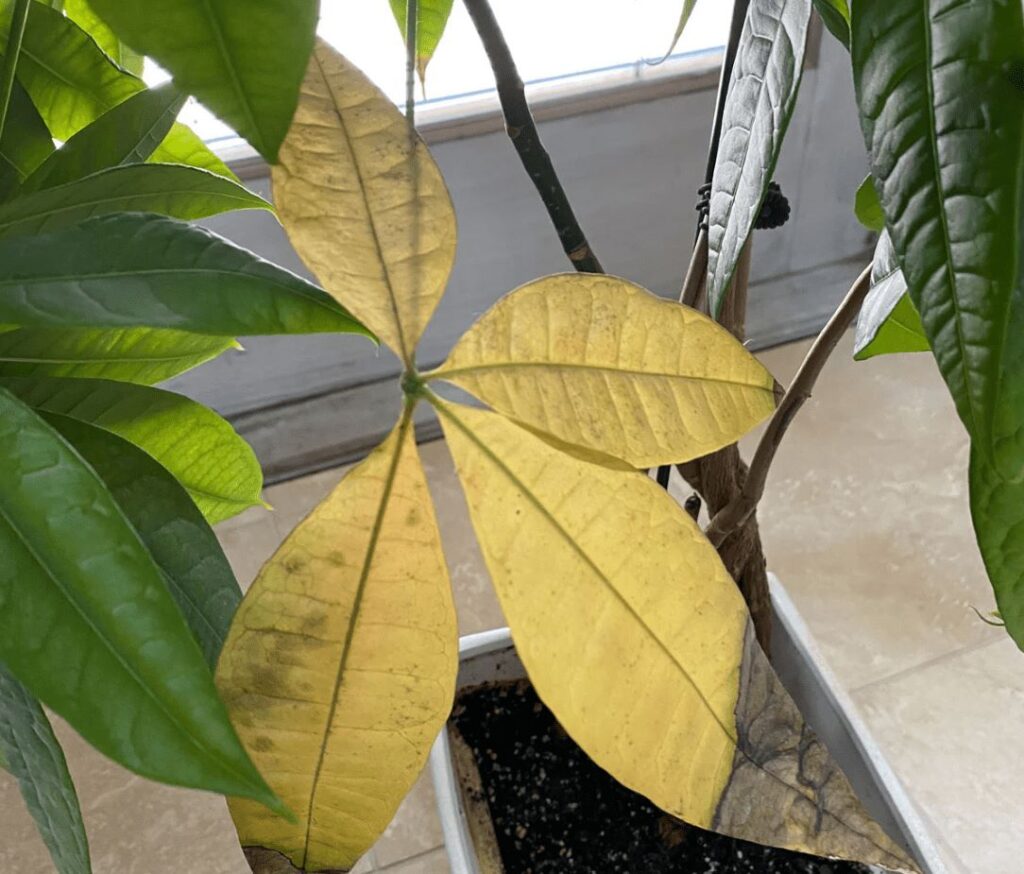
The money tree is a hardy plant that can make a great addition to any home or office. It is popular for its unique braided stem and lush, glossy leaves. However, if not cared for properly the money tree can suffer from water stress and the leaves may start to yellow or fall off. Improved drainage and an appropriate watering schedule can help to revive the money tree if its leaves have started to fall off.
Mimicking the soil moisture conditions in their native environment is key. Water only when necessary, allowing the surface of the soil to dry out before you water again. When it is time to water, make sure you thoroughly drench the root zone.
Why Are My Money Tree Leaves Brown?
The Problem:
Money Tree plants are relatively easy to care for and can be a great addition to any home or office. However, it is important to pay attention to the condition of their leaves as yellowing or browning can be an indication of a problem. While yellow leaves will naturally turn brown before dropping from the plant, it is important to check that the cause of yellowing has already been identified and addressed.
If the leaves have started to turn brown before turning yellow, then this is a sign that something else may be wrong with your Money Tree. Common causes for browning include underwatering, overwatering, too much direct sunlight or low humidity levels in the environment.
Money Tree plants are known for their resilience and can even survive periods of neglect. However, it is important to pay attention to any signs of distress in the leaves as this could indicate a problem that needs to be addressed quickly. Browning of the leaves is one such sign, which can appear as discoloration on the tips or small spots.
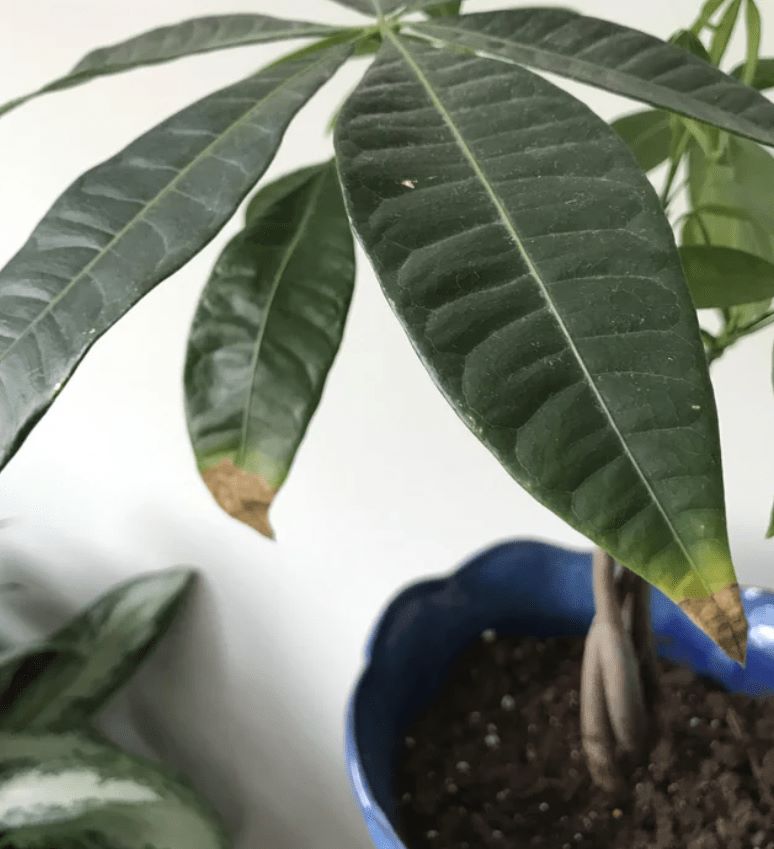
Why Is It Happening?:
OVERWATERING: If you find that your Money Tree is showing signs of overwatering, the first thing to do is to stop watering your plant altogether. This will give the root system a chance to dry out and recover. You can also try to remove some of the soil around the roots in order to expose them to more air.
UNDERWATERING: Underwatering is a common problem for Money Tree plants, as it can lead to leaves that wrinkle, curl up, turn brown, and fall off. If you notice these signs, it usually means that your plant isn’t getting enough water. It is important to ensure that the soil around the plant remains damp and moist at all times. You can do this by regularly checking the soil for moisture and watering your Money Tree when it is needed. Aim to keep the soil around the plant slightly moist, but not soggy or waterlogged. It is also important to make sure that you are using well-draining soil that allows excess water to drain away quickly.
TOO MUCH LIGHT: Leaf scorch is a common environmental concern that can affect Money Trees, particularly when they are exposed to direct sunlight. Too much intense, unfiltered light can cause browning of the leaves due to the higher temperatures and UV radiation. Even if your Money Tree isn’t near a window or an outdoor patio, other heat sources nearby could be causing the issue.
TOO MUCH FERTILIZER: Too much fertilizer can have negative effects on a plant’s growth and health. Excess fertilizer causes the plant to produce excessive top growth, causing a weak root system and an imbalance in the ratio of leaves to roots. This can lead to poor flowering and fruiting production, as well as increased susceptibility to pests and diseases. Too much fertilizer can overwhelm the plant or upset the pH balance of the soil.
How to Revive a Money Tree with Leaves Turning Brown
It’s common for plant lovers to do more harm than good by trying too many solutions at once.
- Move the money tree to an area of bright, indirect light. When it comes to moving the money tree to an area of bright, indirect light, it’s important to be aware of the effects that direct sunlight can have on the plant. Too much sun can cause the leaves to turn brown due to dehydration. To avoid this, it is best practice to find an area where there is enough light for the keep the plant healthy yet not too much sun that the leaves turn brown.
- Snip off any brown, scorched, dried out leaves if they have been burnt in the sun. Pruning brown, scorched or dried leaves from your plants is a necessary and important task for keeping your plants healthy. When the leaves have been exposed to too much sun and become brown, scorched or dried out, they cannot be revived and should be removed with a sharp pair of pruners. Pruning these leaves helps stimulate the growth of new green leaves.
- Water your money tree with a generous soak rather then a light watering. Watering your money tree is essential in order to ensure its health and proper growth. If you give it too light of a watering, the water may not penetrate deep enough into the soil and can cause drought stress. This can result in brown leaves, stunted growth, or root damage. The best way to ensure that your money tree is really generous soak as this ensures the water has infiltrated the soil to reach the roots.
- Water with a generous soak and then wait until the soil is only slightly moist to a fingers depth. When caring for a money tree, it is important to make sure the soil is adequately moist. The best way to do this is to give the tree a generous soak and then wait until the soil is only slightly moist when touched up to your finger’s depth. Doing this keeps the balance of moisture in the soil consistent and healthy for the money.
- Check to see if they roots are pot bound, if so repot your money tree to a pot the next size up. When it comes to repotting your money tree, the most important thing to consider is whether or not the roots are pot bound. If so, then the next step is to repot the tree into a pot that is the next size up. This will give it more room for soil and thus a greater capacity to hold moisture around the roots of the money tree. This can help alleviate drought stress and also revive any dying brown leaves that have been caused by lack of water. It is important to make sure you use a potting soil specifically made for money trees when repotting as this will contain necessary nutrients and minerals for the money tree’s health.
- Locate the money tree away from sources of heat which cause the temperature to fluctuate and out of air currents. When positioning your money tree at home, it is important to avoid placing it in areas where it will be exposed to fluctuating temperatures and air currents. This could cause the leaves of your money tree to turn brown due to a decrease in humidity and moisture loss. Therefore, ensure that you locate your money tree away from sources of heat.
- Increase the humidity around your money tree by misting the leaves regularly. Maintaining a humid micro-climate around your money tree is key to keeping it healthy and happy. While misting the leaves is an important part of this, other factors must be taken into consideration as well. An optimal environment for your money tree requires a relative humidity of roughly 50-60%. In order to achieve this, it may be necessary to use a humidifier or move the plant to an area of the house that is naturally more humid, such as a bathroom. Additionally, be sure to keep your money tree away from direct sources of heat, like radiators or air conditioning vents, which can quickly dry out the leaves and sap their moisture.
- If you live in climate of particularly low humidity, I recommend using a humidifier in the home to emulate the humid conditions of the money tree’s native environment. Humidifiers are a great way to create a more conducive environment for your money tree. As the native habitat of the money tree is one that has higher levels of humidity than most other places, using a humidifier in your home will help mimic those conditions, ensuring that your money tree has the best chance of thriving and growing healthy.
Money tree plants are popular houseplants, and they can be a great addition to your home décor. Unfortunately, brown leaves on a money tree can indicate an unhealthy plant. It is important to act quickly and prune back the brown leaves in order to save the plant.
The first step is to remove any dead or brown leaves with pruners. This should be done carefully, as to not damage the healthy leaves or stems around it. New green growth will emerge in a couple of weeks and your money tree will look healthy again.
Money trees (Pachira aquatica) are attractive, low-maintenance plants that add a unique tropical touch to any room. They are native to tropical areas and thrive in higher humidity levels. To keep your money tree healthy and looking its best, it’s important to recreate the optimal conditions of its native environment.
Putting it All Together – Tips for a Healthy Money Tree
Money Trees are a popular houseplant choice and their long-term health depends on proper care. Putting it all together, here are some tips to keep your Money Tree healthy and happy:
First, be sure to provide adequate watering, with a rule of thumb being to (slowly) water the soil until you can see gently dripping from the bottom of the pot. Aim to water your Money Tree once every one or two weeks, depending on temperature and light levels in its environment.
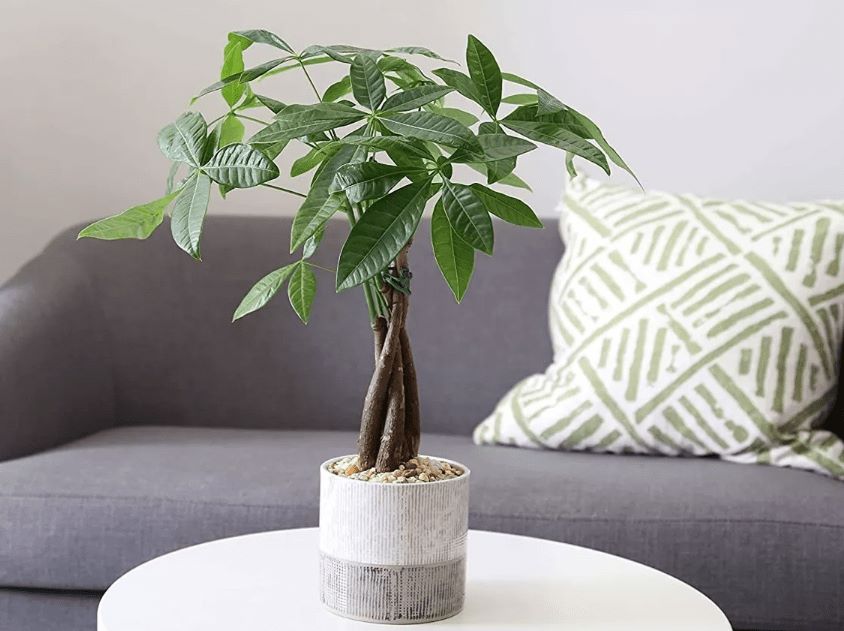
Next, make sure to provide the right amount of sunlight for your Money Tree. As a general rule, place it in an area that gets bright but indirect sunlight—ideally.
Temperature
Money Trees (Pachira aquatica) are beautiful tropical plants that can add a tropical flair to any home. To keep your Money Tree healthy and happy, it’s important to provide the right environmental conditions. Temperature is a key factor in providing the best environment for your Money Tree. The ideal temperature range for a Money Tree is between 65 and 80-degrees Fahrenheit are best.
Water and Humidity
Money Trees are popular houseplants known for their resilience, low maintenance needs, and ability to bring life into any room. Watering and humidity are two key factors to consider when caring for your Money Tree. Water your plant once the top 1-2” of the soil feels dry, and use a moisture meter.
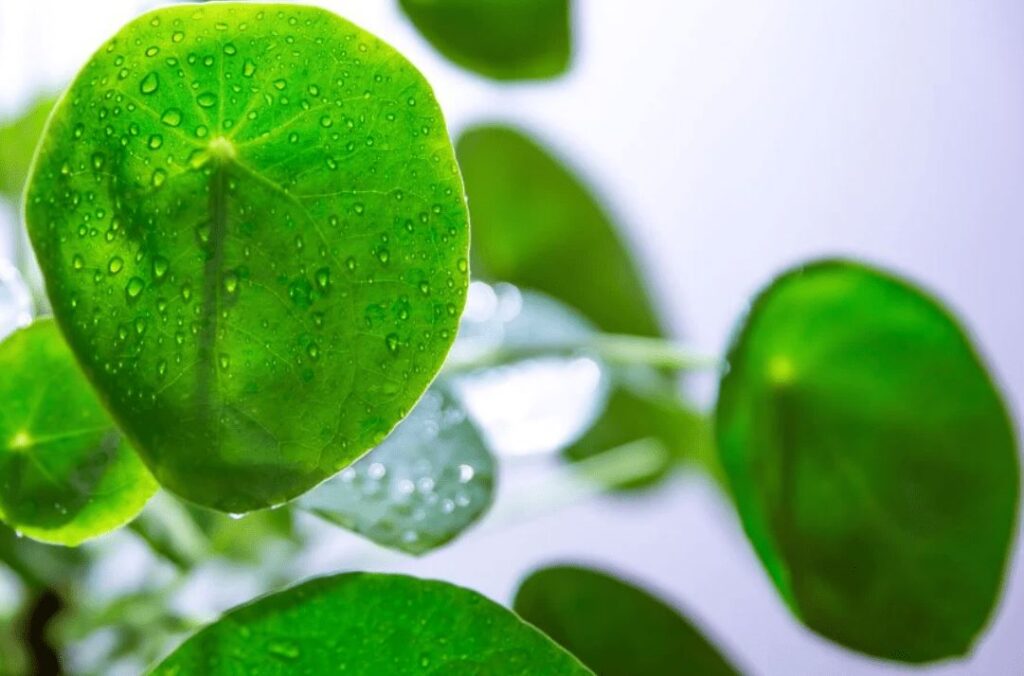
Light
Money trees leaves are sensitive to the sun as they are protected in their native environment from direct light. Money Trees are an increasingly popular choice for houseplants due to their unique appearance and minimal upkeep. For Money Trees to thrive, it is essential to provide them with the proper light source. Light is essential for a Money Tree’s photosynthesis process; however, too much direct sunlight can be damaging to the leaves of your tree.
If your money tree does not get sufficient light, I will try to find a light source and start leaning towards it. In this process, the stem will grow too long and will not have enough energy to grow as many leaves on it and become leggy.
Containers
In selecting the right planter for your Money Tree, there are a few considerations to keep in mind. Containers should be made of breathable materials such as clay, ceramic, or terracotta, with at least one drainage hole on the bottom to allow for proper drainage. While it may be tempting to choose a larger pot than necessary.
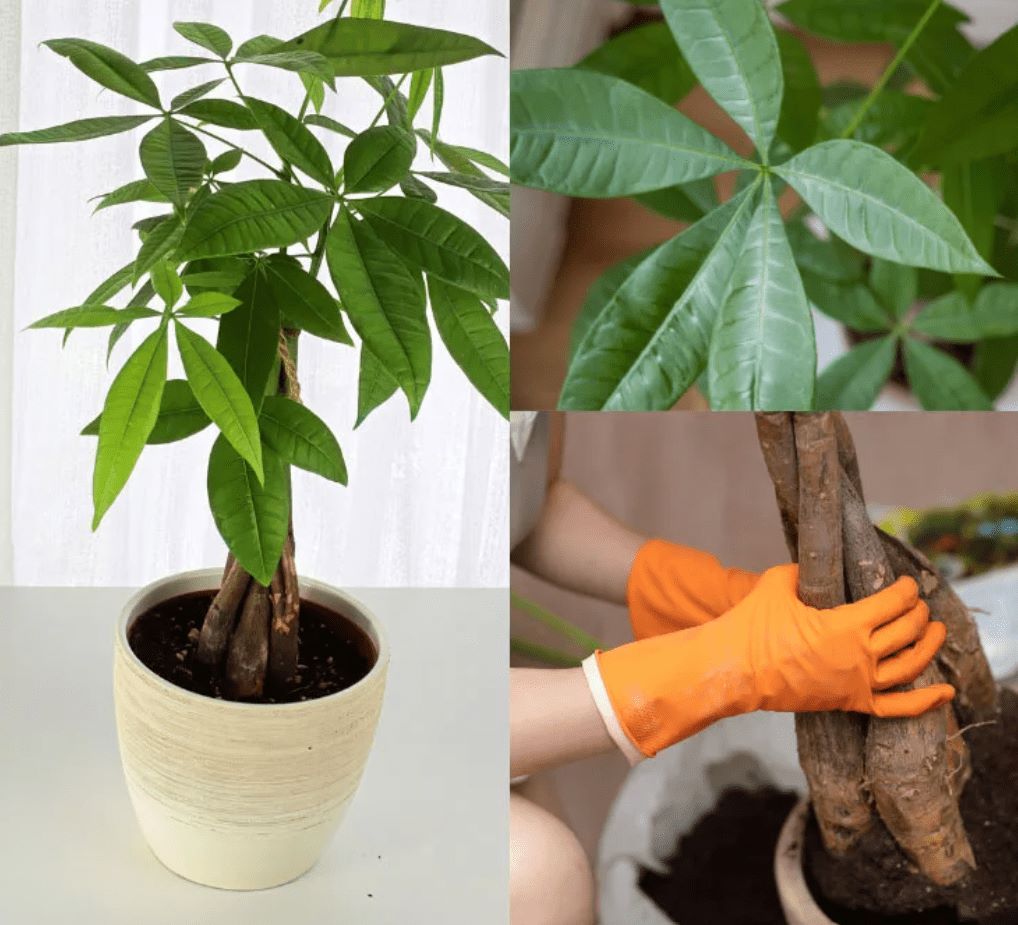
Location
Money Trees are wonderfully lush plants with symbolic meaning for many cultures. They are a great addition to any home or office and can bring good luck, prosperity, and a sense of peace. However, Money Trees do not like to be moved and can become stressed if relocated too frequently. It is important to find the perfect location for your Money Tree, do so slowly and ease the plant into the transition.
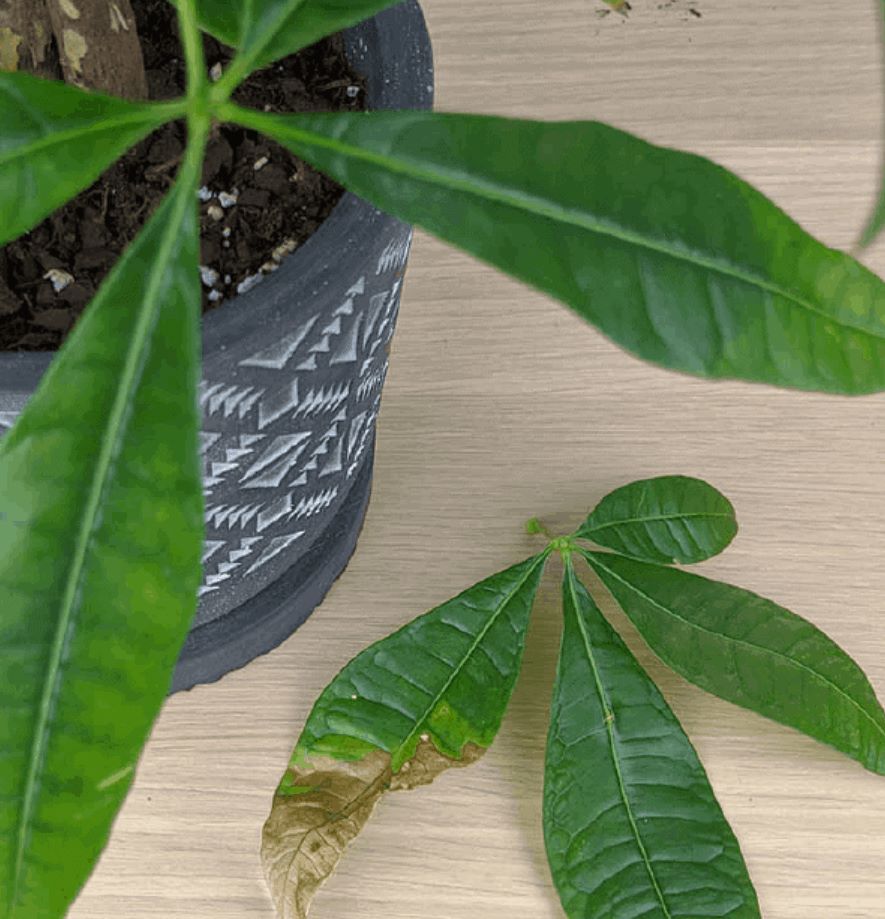
Questions and answers.
Will money tree leaves grow back?
The money tree, or Pachira aquatica, is a species of tropical wetland tree that is native to Central and South America. It has become popular as an ornamental houseplant due to its unique braided trunk and vibrant foliage. Will money tree leaves grow back? The answer is yes! Money trees are considered resilient plants.
How do I know when my money tree is dying?
If your money tree is suffering from root rot, there are several signs you should look out for. The leaves of the tree may start to wilt, discolor, or drop off; the soil may give off a putrid smell; and the base of the stem may become soft or mushy.
How can you tell if a money tree has root rot?
One of the telltale signs that a money tree has root rot is its root system. To get a better look at the roots, it is best to gently run them under warm water in your sink and try to remove as much soil from the roots as possible. Be very careful not to damage them during this process.
Should I cut off brown money tree leaves?
Pruning browning leaves is an important part of keeping a money tree healthy and happy. Removing damaged or dying leaves helps to encourage new growth, which in turn can help keep the plant growing strong year after year. To do this, simply cut off any dead or dying leaves at the base of the stem as soon. Read also…

